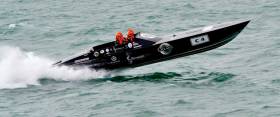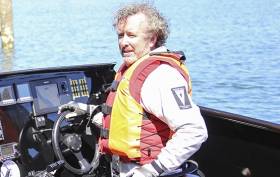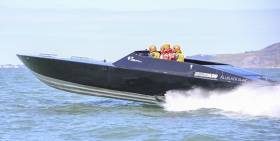Displaying items by tag: John Ryan
Discovering the Six Metre 'Southern Cross' Painting by John Ryan
Pete Hogan on receiving a painting by John Ryan that depicts Ryan's boat from the artist's book "A Wave of the Sea"
A friend recently arrived at my place and presented me with a nice picture of a sailing boat. 'Here you are,' he said. 'You might like this'.
Signed simply 'Ryan' I recognised immediately that it was a painting by Dubliner John Ryan (1925 – 1992). It's of a yacht running under a spinnaker through Dalkey Sound. The Muglins and Howth Head are in the background. The yacht looked a bit like a Dublin Bay 24 with its small raised doghouse and big mainsail. Then I noticed the number on the sail - 6, followed then a K27. It didn't take me long to deduce that it was a 6 Metre and of UK registration – the K27.
I was delighted with the painting and embarked upon a bit of further research.
John Ryan will be familiar to many as a central figure in the Dublin literary scene of the immediate post-war years. Ryan was the publisher of Envoy Magazine, which first featured stories by Behan and Dunleavy. He owned the Baily Pub, was a friend of Patrick Kavanagh and was a Joycean enthusiast when it was neither popular nor profitable. In this regard, he had been instrumental in opening the Joyce Museum in the Sandycove Martello tower and saved the door of Bloom's house at 7 Eccles St. when the house was demolished. He is famously credited with establishing Bloomsday as a celebration of Irish literary traditions.
John Ryan had written two books - 'Remembering How we Stood' (still in print) and 'A Wave of the Sea'. With the latter book, I struck gold. On the title page, there is a drawing of the same 6-metre yacht K 27, in the same pose as the painting I had just been given. I quickly realised I had John Ryan's picture of his boat, Southern Cross. The book, A Wave of the Sea, is mainly about his sailing exploits in this boat.
 The front piece of Ryan's Book A Wave of the Sea
The front piece of Ryan's Book A Wave of the Sea
 Illustration from Ryan's book
Illustration from Ryan's book
 Southern Cross
Southern Cross
Southern Cross had been built in 1928 as a racing 6 metre and competed in the Olympics of 1936. Her records are still on the excellent 6 Metre Class website (6metre.com). By 1948 when she retired from racing, she was converted to cruising with the addition of a cabin. This was a common fate for both six and 8-metre yachts as they made handy cruisers in those days before the event of fibreglass boats. Up to six 6 metres in Dun Laoghaire in the 1960's racing in the top cruiser class. (I remember in particular Rainbow 2 excellently sailed by Launce Mc Mullen).
John Ryan does not seem to have raced Southern Cross much but enjoyed cruising with his favourite crew, 'the Briar', who he befriended in one of the Dun Laoghaire bars. The Briar comes across as a nautical equivalent of Ryan's other bawdy friend, Brendan Behan. Together they cruised and caroused the length and breadth of the Irish Sea, around Ireland and many English ports.
John Ryan contributed to the radio programme Sunday Miscellany frequently on marine subjects. He took a keen interest in the Spanish Armada.
The painting of the Southern Cross is quite typical of Ryan's output. He took a lot of care to get the nautical details correct. I was surprised by the complex three-spreader rig on the mast but realised it is probably correct on an old racing six mast. The pre-Dacron mainsail is multi-panelled as the old cotton sails were. What looks like a female crew on the foredeck is attending to the spinnaker, something which is absent from the drawing in the book. The sky is well-painted and dramatic. There is a yacht in the middle distance beating to windward.
Perhaps it is a race, as both yachts sport the old square racing flags. Racing flags were de rigour in the old days. They were square and indicated to other yachts the fact that one was racing and they should get the hell out of the way. Interestingly, the Southern Cross is sporting a burgee, a triangular flag, of indeterminate identity in the book drawing. Also in the distance is a passenger ferry that could be one of the old Isle of Man steam packet ships operated from 1946 to 1982. A fleet of racing sails in the far distance and some seabirds complete the detail. Quite a busy picture.
 A female crew on the foredeck is attending to the spinnaker
A female crew on the foredeck is attending to the spinnaker
A female crew on the foredeck is attending to the spinnaker
 The yacht looked a bit like a Dublin Bay 24 with its small raised doghouse and big mainsail
The yacht looked a bit like a Dublin Bay 24 with its small raised doghouse and big mainsail
There are a few paintings by John Ryan on the internet, usually from auction room catalogues.
I am attempting to write an appreciation of John Ryan as a marine painter, which hopefully would be published in a learned journal.
I would be grateful if anyone out there could send me details of his paintings that they might have or know the location of. There is a very fine example in the National Yacht Club. The OPW is supposed to have one, but I cannot track it down. He exhibited over a long career in the RHA and other exhibitions, including ROSC. Perhaps some curious art student might try and assemble a catalogue raisonné of his work.
Pete Hogan. [email protected]
(With thanks to David Pearson and Colin Mc Mullen).
 Detail of the Ryan painting in the National Yacht Club, Dun Laoghaire
Detail of the Ryan painting in the National Yacht Club, Dun Laoghaire
#Powerboats - An Irish-based powerboat racing team is aiming for a full 11 offshore endurance and speed records over the next three years.
“It’s ambitious, but it’s do-able,” as Red Bull hears from John Ryan, team driver and throttle man with Allblack Racing and an Afloat.ie Sailor of the Month in his own right for Team Hibernia’s record-smashing Round Ireland powerboat run.
The 11 challenges of the Union International Motonautique (UIM) offshore ocean endurance long distance and speed records represent a step beyond for Ryan and his team mates.
Allblack Racing will take to Irish waters again for the Cork-Fastnet loop and the Round Britain and Ireland challenge, as well as the Round Anglesey run in the Irish Sea and Menai Strait.
The team will also tackle various taxing European routes such as an Italian speed trial from Naples to Capri, a blast between the Channel Islands and the Isle of Wight, and a straight 60-hour run from London to Monte Carlo.
That’s not to mention the epic routes from London to St Petersburg and Miami to New York that will complete the list — all raced on the team’s Swedish-designed Allblack SL44 that's been specially adapted for extreme racing.
Allblack from Konjow Films on Vimeo.
What’s more, there’s an opportunity for additional passengers to join Ryan and his team mates Philip Fitzgibbon and Ant Middleton — if you can bring funding for the demands of each record, you could get trained up and listed as co-driver for the fourth seat on the boat.
Red Bull has much more on the story HERE.
With his splendid achievement on Sunday of chopping six hours off the established Round Ireland powerboat record time, John Ryan is acclaimed as May’s Powerboat “Sailor of the Month” with a breakthrough which could stand for quite some time.
Ryan and his crew of defending record holder Philip Fitzgibbon, together with Sean MacNamara and Denis Dillon, took full advantage of ideal conditions. The impressive black 40ft Team Hibernia recorded a clockwise circuit from Kinsale with a massive 33% reduction in the standing eighteen hour time. Admittedly Fitzgibbon’s 2009 time was achieved in a RIB of les than 30ft and he continues to hold the under-30ft record. But the John Ryan-led new record of 12 hours 54 minutes and 24 seconds is a very special time indeed, and well worthy of spreading the “Sailor of the Month” awards into an additional category.
Read more: Round Ireland powerboat record
Round Ireland Powerboat Record Bid This Weekend
A bid to break the 2009 Round Ireland powerboat record will be made this weekend. Venture Cup entrant John Ryan and his Team Hibernia crew will make an attempt at the record on Sunday. Starting in Kinsale on the South Coast, Ryan and his four man crew will need to be back in the Munster harbour within 19 hours if they are to break the seven–year–old record set in a time of 18 hours 38 minutes and 50 seconds.
Hibernia Racing's 100 mph –ALLBLACK SL44 entry is built for marathon racing and has a range of 500–miles, making it possible for the circumnavigation to be made with just one refuel stop. The sleek aluminium built craft was testing in Cork Harbour a month ago and was powering around Dublin Bay in the past fortnight as preparation for the now cancelled Venture Cup.
The 2009 record holder Philip Fitzgibbon will be part of this weekend's attempt and joins the four–man crew as navigator. Sean McNamara and Denis Dillon complete the line–up.
'We''re going clockwise from Kinsale. I'm keen to get the Atlantic out of the way first', Ryan told Afloat.ie this afternoon.
Fitzgibbon and Mike Shanahan reclaimed their Round Ireland Powerboat Record powering over the Kinsale finish line to become the first team to set a sub 19–hour time for the circumavigation of Ireland in October 2009. The record was set in a 7.5 metre RIB powered by a 250hp engine.
Body Recovered From River Boyne Thought To Be Missing Young Man
#Missing - Gardaí have said they are satisfied that a body recovered from the River Boyne yesterday afternoon (Saturday 23 August) is that of missing Meath man John Ryan, as The Irish Times reports.
The remains of the 20-year-old – who had been missing from Mornington in Co Meath since last Tuesday – were removed from the Boyne by Drogheda River Rescue during a search, and are expected to be positively identified today.
New Angling Guide for Lough O'Flynn and Upper Suck
#INLAND WATERWAYS - Inland Fisheries Ireland (IFI) officially launched the Lough O’Flynn and Upper Suck Angling Guide at the Old Stonehouse Restaurant in Ballinlough recently.
The guide opens to Lough O'Flynn, a 300-acre limestone lake situated 2km from Ballinlough and one of IFI’s many managed lakes requiring a permit.
This lake holds a stock of wild brown trout and is also stocked with brown trout each year which provides an excellent opportunity for all kinds of anglers and those wishing to take up the sport to learn how to fish for trout.
Meanwhile, the centrefold of the guide showcases the Upper Suck catchment from Lough O’Flynn through Co Roscommon and Galway until the Shiven tributary joins, along which good quality coarse, pike and trout angling can be expected.
With breathtaking scenery, this is the perfect place for anglers who can fish almost undisturbed from dawn till dusk.
There are also a considerable number of sections dedicated to anglers with disabilities, such as the Donamon angling stretch which has 30 fishing stands available with individual car parking bays and toilet facilities. This section has proven extremely popular, and IFI says it is committed to ensuring that sections like Donamon continue to open fishing up for everyone.
Amanda Mooney, director at IFI, said: “The guide offers a great source of information on angling hotspots for various types of species, access points and facilities, legislation and safety.
"All in all everything you need for planning a fishing trip. The guide and angling promotion in general supports local businesses and communities in sustaining jobs.”
The Lough O’Flynn and Upper Suck Angling Guide is available from IFI outlets and local permit agents in Ballinlough, Co Roscommon.
Inland Fisheries Ireland also marked the retirement of John Ryan, assistant inspector for Lough O’Flynn and the Suck catchment, after 41 years of service.
Ryan was involved in many areas and aspects of fisheries throughout his career, and was particularly noted for his positive engagement with various groups from angling clubs and development associations to local authorities, businesses and communities.


































































